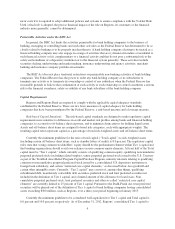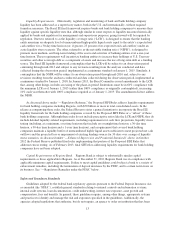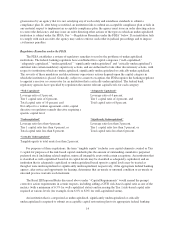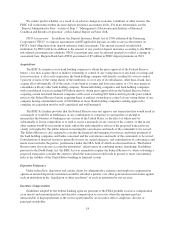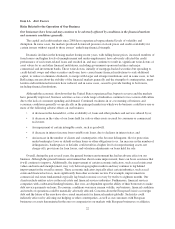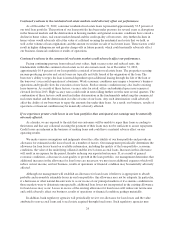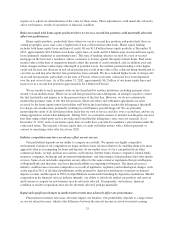Regions Bank 2012 Annual Report Download - page 33
Download and view the complete annual report
Please find page 33 of the 2012 Regions Bank annual report below. You can navigate through the pages in the report by either clicking on the pages listed below, or by using the keyword search tool below to find specific information within the annual report.Deposit Insurance Assessments. Regions Bank pays deposit insurance premiums to the FDIC based on an
assessment rate established by the FDIC. Regions’ FDIC assessment rates were previously calculated based upon
a combination of regulatory ratings and financial ratios. However, in February 2011, the FDIC adopted a final
rule (the “New Assessment Rule”), which took effect on April 1, 2011, to revise the deposit insurance assessment
system for large institutions. The New Assessment Rule creates a two scorecard system for large institutions, one
for most large institutions that have more than $10 billion in assets, such as Regions Bank, and another for
“highly complex” institutions that have over $50 billion in assets and are fully owned by a parent with over
$500 billion in assets. Each scorecard has a performance score and a loss-severity score that are combined to
produce a total score, which is translated into an initial assessment rate. In calculating these scores, the FDIC
utilizes the bank’s supervisory (“CAMELS”) ratings as well as forward-looking financial measures to assess an
institution’s ability to withstand asset-related stress and funding-related stress. The FDIC has the ability to make
discretionary adjustments to the total score, up or down, based upon significant risk factors that are not
adequately captured in the scorecard. The total score is then translated to an initial base assessment rate on a non-
linear, sharply-increasing scale. For large institutions, including Regions Bank, the initial base assessment rate
ranges from 5 to 35 basis points on an annualized basis (basis points representing cents per $100). After the
effect of potential base-rate adjustments, the total base assessment rate could range from 2.5 to 45 basis points on
an annualized basis. The potential adjustments to an institution’s initial base assessment rate include (i) a
potential decrease of up to 5 basis points for certain long-term unsecured debt (“unsecured debt adjustment”) and
(ii) (except for well-capitalized institutions with a CAMELS rating of 1 or 2) a potential increase of up to
10 basis points for brokered deposits in excess of 10% of domestic deposits (“brokered deposit adjustment”). As
the DIF reserve ratio grows, the rate schedule will be adjusted downward. Additionally, the rule includes a new
adjustment for depository institution debt whereby an institution will pay an additional premium equal to 50 basis
points on every dollar (above 3% of an institution’s Tier 1 capital) of long-term, unsecured debt held that was
issued by another insured depository institution, excluding debt guaranteed under the FDIC’s Temporary
Liquidity Guarantee Program (TLGP). The New Assessment Rule also changed the deposit insurance assessment
base from deposits to the average of consolidated total assets less the average tangible equity of the insured
depository institution during the assessment period.
Regions began using the New Assessment Rule for FDIC expense calculations beginning with the second
quarter of 2011. During 2011, FDIC insurance expense decreased $3 million to $217 million. Regions insurance
expense further decreased by $55 million to $162 million during 2012. The level of FDIC deposit expense is
expected to fluctuate over time depending on the results of the calculations using the factors discussed above.
The FDIA establishes a minimum ratio of deposit insurance reserves to estimated insured deposits, the
designated reserve ratio (the “DRR”), of 1.15 percent prior to September 2020 and 1.35 percent thereafter. On
December 20, 2010, the FDIC issued a final rule setting the DRR at 2 percent. Because the DRR fell below
1.15 percent as of June 30, 2008, and was expected to remain below 1.15 percent, the FDIC was required to
establish and implement a restoration plan that would restore the reserve ratio to at least 1.15 percent within five
years. In October 2008, the FDIC adopted such a restoration plan (the “Restoration Plan”). In February 2009, in
light of the extraordinary challenges facing the banking industry, the FDIC amended the Restoration Plan to
allow seven years for the reserve ratio to return to 1.15 percent. In October 2009, the FDIC passed a final rule
extending the term of the Restoration Plan to eight years. This final rule also included a provision that
implements a uniform three basis point increase in assessment rates, effective January 1, 2011, to help ensure that
the reserve ratio returns to at least 1.15 percent within the eight year period called for by the Restoration Plan. In
October 2010, the FDIC adopted a new restoration plan to ensure the DRR reaches 1.35 percent by September
2020. As part of the revised plan, the FDIC did not implement the uniform three-basis point increase in
assessment rates that was scheduled to take place in January 2011. The FDIC will, at least semi-annually, update
its income and loss projections for the DIF and, if necessary, propose rules to further increase assessment rates.
In addition, on January 12, 2010, the FDIC announced that it would seek public comment on whether banks with
compensation plans that encourage risky behavior should be charged higher deposit assessment rates than such
banks would otherwise be charged. Comments were due February 18, 2010. As of February 2013, no rule has
been adopted. See also “—Incentive Compensation” below.
17




